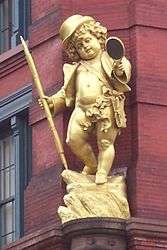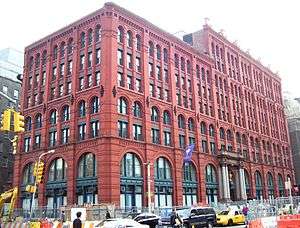Puck Building
|
Puck Building | |
|
from Houston Street (2010) | |
   | |
| Location |
295-307 Lafayette Street Manhattan, New York City |
|---|---|
| Coordinates | Coordinates: 40°43′29″N 73°59′43″W / 40.7248°N 73.9953°W |
| Built | 1885–86 |
| Architect | Albert and Herman Wagner |
| Architectural style | Rundbogenstil |
| NRHP Reference # | 83001740[1] |
| Significant dates | |
| Added to NRHP | July 21, 1983 |
| Designated NYCL | April 12, 1983 |
The Puck Building is a historic building located in the Nolita neighborhood of Manhattan, New York City. It occupies the block bounded by Lafayette, Houston, Mulberry and Jersey Streets.
An example of the German Rundbogenstil style of Romanesque Revival architecture,[2] the building was designed by Albert Wagner,[3] and was constructed in two parts. The north section was built in 1885–86, and the south addition in 1892–93.[3] The front of the building – on Lafayette Street – was relocated in 1899 when the street – then called Elm Place[4] – was widened, this was supervised by Herman Wagner.[3] The building was rehabilitated in 1983–84 and further renovated in 1995 by Beyer Blinder Belle.[3] The building sports two gilded statues by sculptor Henry Baerer of Shakespeare's character Puck, from A Midsummer's Night Dream, one on the northeast corner at Houston and Mulberry, and one over the main entrance on Lafayette.[3]
The building is located at the northwestern corner of Manhattan's NoLIta neighborhood, bordered by SoHo and the NoHo section of Greenwich Village. It is owned by Kushner Properties, the company of Charles Kushner, a major donor to Democratic politicians in New Jersey, and his son Jared Kushner, the owner of The New York Observer.
History

The building was constructed as the printing facility of J. Ottmann Lithographic Company as a seven-story structure, with a nine-story structure added on in 1892.[5]
The building was the longtime home of Puck magazine, which gave the building its name; Originally founded in St. Louis in 1871, the magazine moved into the building in 1887 and remained there until it ceased publication in 1918.[6]
A June 1887 fire caused significant damage, estimated as high as $30,000, including water damage to the editorial rooms used by Puck magazine.[7] A fire in November caused $50,000 in damage after a can of turpentine caught on fire inside a finishing room where workers were producing Christmas cards.[8]
The building later housed numerous independent printing firms and related printing services such as typesetters and a printing ink company, Superior Printing Ink. The odor of printing ink permeated the building for many years. An office stationery company, S. Novick & Son, once occupied the second floor. Notable among that firm's salesmen was Alger Hiss, the former Assistant Secretary of State, who was brought down in a spy scandal in the 1950s.[9]
The Serra family bought the building in 1978 and allowed the building to empty out as tenants left over the years as their leases expired.[5] A proposed 1981 conversion of the building eliminated the inclusion of residential space based on the economics of paying displaced commercial tenants a fee of $9 per square foot.[10] The building reopened in April 1983 after an $8 million renovation and restoration project that created condominium spaces for businesses primarily related to the arts.[5]
Owner Jared Kushner sought approval from the Landmarks Preservation Commission to erect six penthouse apartments at the top of the red-brick building. After initially being turned down in October 2011, Kushner made two modifications and his plans were approved. The first of the six units closed in May 2014, selling for $28 million.[11]
Tenants
In the 1980s, the Puck Building was the original home of Spy Magazine.[12] Starting in 1986, the building housed the Manhattan Center of Pratt Institute.[13] Pratt used the additional space for computer and technical labs for the School of Computer, Information, and Library Science (SCILS).
Since 2004, the building has been used by New York University for the Wagner Graduate School of Public Service and the department of sociology.[14]
The building contains both office and retail space as well as ballrooms for large events on both the top and ground floors. The Skylight Ballroom can accommodate 250 guests, while the Grand Ballroom can fit up to 1,000.[15]
The retail space was added when the building underwent a large-scale renovation beginning in October 2011.
In 2011, REI opened a 35,000-square-foot (3,300 m2) store spanning the building's first three levels.[16] The renovation was designed by architects Callison and includes an area that showcases the history of the Puck Building.[16]
In popular culture
- During Little Italy's annual Feast of San Gennaro, which takes place on Mulberry Street, strings of lights are strung from the building's Mulberry Street walls.
- An exterior shot of the Puck Building is seen in the American television sitcom Will & Grace, as the building where the title character Grace Adler (played by Debra Messing) works.[17]
- An exterior shot of the Puck Building was seen on the American television Seinfeld in the episode "The Kicks", when Elaine hosts a company party there.
- In the 1989 film When Harry Met Sally..., the building is the site of a big fight between Harry (Billy Crystal) and Sally (Meg Ryan) during the wedding of their best friends Marie (Carrie Fisher) and Jess (Bruno Kirby), as well as the site of a New Year's Eve party at the end of the film where Harry says that he loves Sally.[18]
- The final scene of the 1989 Kevin Kline film January Man was shot at the Puck Building, featuring both interior and exterior shots.
- The Puck Building serves as the venue for a black-tie party in the 1991 Bret Easton Ellis novel American Psycho.[19]
References
- ↑ National Park Service (2009-03-13). "National Register Information System". National Register of Historic Places. National Park Service.
- ↑ "New York Architecture Images- Puck Building". nyc-architecture.com. Retrieved 21 January 2015.
- 1 2 3 4 5 White, Norval & Willensky, Elliot (2000), AIA Guide to New York City (4th ed.), New York: Three Rivers Press, ISBN 978-0-8129-3107-5 p.87
- ↑ Friedman, Walter; and Opdycke, Sandra. "Puck" in Jackson, Kenneth T., ed. (1995), The Encyclopedia of New York City, New Haven: Yale University Press, ISBN 0300055366 p.961
- 1 2 3 Gaiter, Dorothy J. "Restored Puck Building Opens Today", The New York Times, April 20, 1983. Accessed May 9, 2016. "The landmark Puck Building in SoHo that was once the largest in the world devoted to lithography and publishing will reopen today after three years of restoration as a condominium for arts and industry."
- ↑ Haden-Guest, Anthony. "The Magazine That Made—and Unmade—Politicians", The Daily Beast, November 2, 2014. Accessed May 9, 2016. "Puck, a humor magazine that was known for its cartoons of pointed political satire, was launched in St. Louis in 1871, but moved to New York a few years later to begin publishing out of the splendid steel-frame building in 1887.... Puck was a waning force by then. It went to black and white in 1916, died in 1918."
- ↑ "Fire in the Puck Building; Much Damage Done by the Water Thrown Upon it", The New York Times, June 26, 1887. Accessed May 9, 2016.
- ↑ Staff. "PUCK BUILDING BLAZE FOLLOWS FACTORY FIRE; Croker's Men Kept Busy in the Downtown District. GIRLS IN PANIC ON LADDERS Three Firemen Caught in a Nasty Trap, but Were Rescued -- Damage, $150,000 in All.", The New York Times, November 4, 1905. Accessed May 9, 2016.
- ↑ White, G. Edward (2010-11-17). "Alger Hiss's Campaign for Vindication (PDF)" (PDF). Boston University Law Review. HeinOnline. 83 (64): 77. Retrieved December 24, 2015.
- ↑ Oser, Alan S. "Real Estate; SoHo Loft For Use as Galleries", The New York Times, November 25, 1981. Accessed May 9, 2016. "The Puck building was at first going to be a mixed-use building. But the higher costs of residential development, and the new loftlaw requirement that would have forced the sponsor to pay relocated commercial tenants $9 a square foot, have changed the economic balance, said Aaron Gelbwaks, the sponsor's attorney."
- ↑ Horsley, Carter. "The Puck Penthouses, 293 Lafayette Street". City Realty.
- ↑ Riley, Sam G.; and Selnow, Gary W. Regional Interest Magazines of the United States, p. 320. Greenwood Publishing Group, 1991. ISBN 9780313268403. Accessed May 8, 2016. "Spy was originally housed in the Puck Building in Downtown Manhattan."
- ↑ Kennedy, Shawn G. "Real Estate; A New Use For Puck Building", The New York Times, August 20, 1986. Accessed May 8, 2016. "Pratt has taken the second floor and will move its Manhattan Center there from 160 Lexington Avenue."
- ↑ "NYU Inks Deal for 'Dream Space' in Puck Building", New York University, June 21, 2013. Accessed May 8, 2016. "New York University and Kushner Companies announced that the University has signed a 15-year lease for three floors, comprising 75,000 square feet of contiguous space, in the historic Puck Building, 295 Lafayette Street in Manhattan's SoHo neighborhood."
- ↑ "The Puck Building", New York (magazine). Accessed May 9, 2016. "This landmark Soho building boasts more than 14,000 square feet of event space. The high-ceilinged Grand Ballroom is vast—it can hold 1,000 guests—with white walls and columns, two chandeliers, and white curtains that can be parted to yield an incredible amount of natural light. The seventh-floor Skylight Ballroom seats up to 250 guests."
- 1 2 Mao, Tien (December 2, 2011). "Photos: REI SoHo Opens Its Doors in the Puck Building". Gothamist. New York. Retrieved May 3, 2016.
- ↑ "On Set in the Village", Greenwich Village Society for Historic Preservation, September 30, 2011. Accessed May 8, 2016. "Let’s start with Will & Grace. Where was Grace Adler Designs located? Why, in the Puck Building of course."
- ↑ Alleman, Richard. New York: The Movie Lover's Guide: The Ultimate Insider Tour of Movie New York, p. 284. Crown/Archetype, 2013. ISBN 9780804137782. Accessed May 9, 2016.
- ↑ Ellis, Bret Easton (1991) American Psycho New York: Vintage. p.126 ISBN 0-679-73577-1
External links
 Media related to Puck Building at Wikimedia Commons
Media related to Puck Building at Wikimedia Commons- The Puck Building (caterer's commercial site)
- Puck Building on New York Architecture


